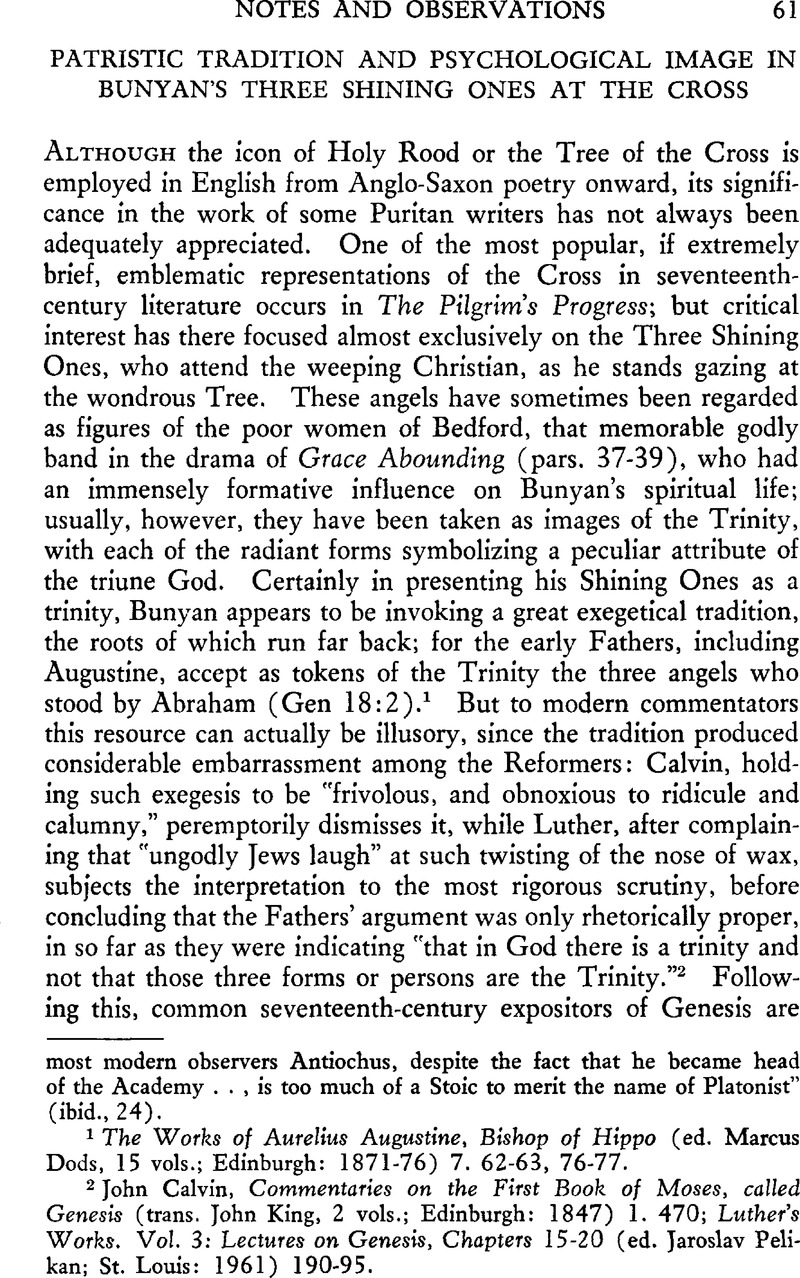No CrossRef data available.
Published online by Cambridge University Press: 10 June 2011

1 The Works of Aurelius Augustine, Bishop of Hippo (ed. Dods, Marcus, 15 vols.; Edinburgh: 1871–1876) 7. 62–63Google Scholar, 76–77.
2 Calvin, John, Commentaries on the First Book of Moses, called Genesis (trans. King, John, 2 vols.; Edinburgh: 1847) 1. 470Google Scholar; Luther's Works. Vol. 3: Lectures on Genesis, Chapters 15–20 (ed. Pelikan, Jaroslav; St. Louis: 1961) 190–95Google Scholar.
3 Andrew Willett (citing Calvin) in Hexapla in Genesin (Cambridge: 1605) 202–03; John Diodati, Pious and Learned Annotations upon the Holy Bible (3rd ed.; London: 1651) sig. E2; Ainsworth, Henry, Annotations on the Pentateuch (2 vols.; Glasgow: 1843) 1.97Google Scholar; Gervase Babington, Certain plaine, brief and comfortable Notes upon every Chapter of Genesis, in Workes (London: 1615) 70; etc.
4 Boehme, Jacob, Mysterium Magnum, or, An Exposition of the First Book of Moses called Genesis (trans. Sparrow, John, ed. C. J. B., 2 vols.; London: 1924) 1. 390Google Scholar.
5 Benjamin Keach, Tropology: A Key to Open Scripture Metaphors (London: 1681) 229.
6 Robertson, D. W. Jr, “The Doctrine of Charity in Mediaeval Literary Gardens: A Topical Approach through Symbolism and Allegory,” Speculum 26 (1951) 26CrossRefGoogle Scholar. On the Tree of Knowledge of Good and Evil as symbolizing free-will, see, among others, Isidore of Seville, De vetere et novo testamentis quaestiones, in Migne, PL 81. 216. The association of the tree with free-will appears also in Langland (Passus xvi, B text), where the gardener who looks after the tree is said to be liberum arbitrium. The three props mentioned are also interpreted as symbols of the Trinity. Langland gives a picture-view of the Incarnation after the fruit has been plucked, when he has Piers snatch at the second of the props to put the devil to flight. In medieval literature there is an immense complex of signification attaching to the tree, especially to the trees of Eden. On these as figures of the thoughts and meditations of men and angels, see Moses Bar Cephas, Commentarius de Paradiso, in Migne, PG 3. 583; on the same as images of useful knowledge, see Augustine, The City of God 13.21. Augustine elsewhere equates vegetation with the intellect: cf. Marvell's “green thought in a green shade.”
7 Augustine: Later Works (trans. Burnaby, John; London: 1955) 167–71Google Scholar, passim.
8 The Sermons of John Donne (ed. Potter, George R. and Simpson, Evelyn M., 10 vols.; Berkeley and Los Angeles: 1953–1962) 2. 72–73Google Scholar.
9 William Sherlock, A Vindication of the Doctrine of the Holy and Ever Blessed Trinity (3rd ed.; London: 1694) 50.
10 In a recent perceptive study, Stanley Fish has quite properly pointed to a recurring theme of memory in the allegory: “Every crisis in The Pilgrim's Progress is a crisis of memory.” The statement is true, in so far as his definition of memory as “an act of the will in which the consciousness calls on something that is not literally there in order to interpret correctly what is (or seems to be) there” incorporates all the components of seventeenth-century faculty psychology and acknowledges an analogy between remembering and faith. See Fish, Stanley E., Self-Consuming Artifacts: The Experience of Seventeenth-Century Literature (Berkeley: 1972)Google Scholar Ch. 4, espec. 250–51.